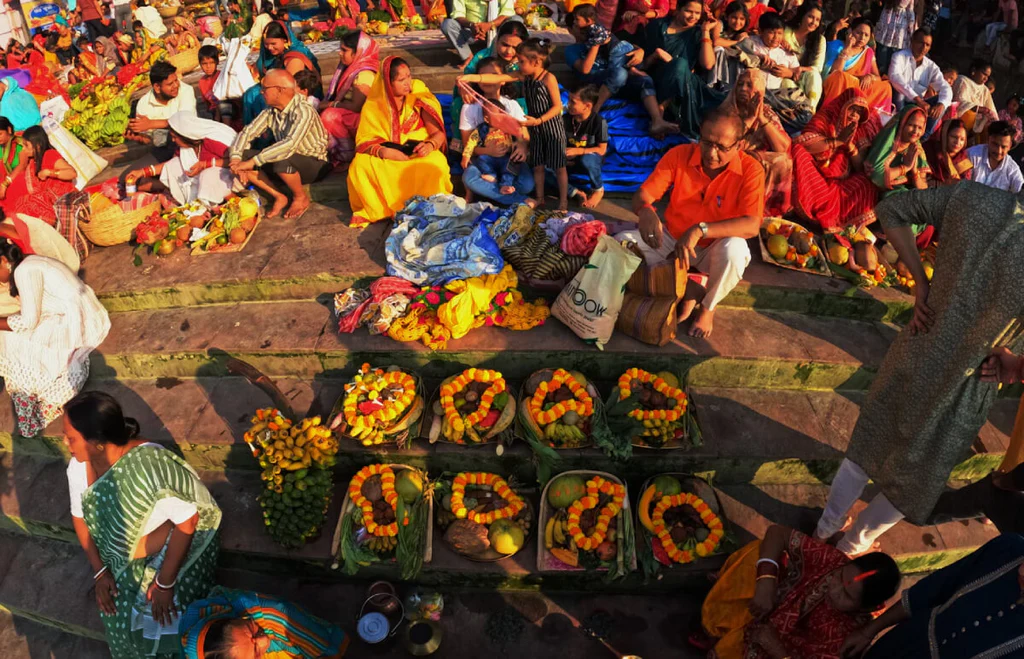Chhath Puja in Bihar : A Festival of Devotion, Sun, and Simplicity India is known for its diverse festivals, and each region celebrates traditions that reflect its culture and faith. Among the many grand festivals of India, Chhath Puja holds a special place, especially in Bihar, Jharkhand, and eastern Uttar Pradesh. Unlike most festivals that involve idol worship, Chhath Puja is unique because it is dedicated to the Sun God (Surya) and his sister Chhathi Maiya, who is believed to bless devotees with health, prosperity, and longevity.
In Bihar, Chhath Puja is not just a ritual—it is an emotion, a cultural identity, and a way of life. This four-day-long festival is celebrated with unmatched devotion, discipline, and purity. Let us take a closer look at the origins, rituals, significance, and cultural impact of Chhath Puja in Bihar.

Table of Contents
1. Origins and Significance of Chhath Puja
Chhath Puja is considered one of the oldest Hindu festivals, with references found in the Rig Veda and ancient scriptures. It is believed that Draupadi and the Pandavas performed Chhath Puja during the Mahabharata era to overcome difficulties and seek blessings.
The festival is dedicated to Surya Dev, the provider of life and energy, and Chhathi Maiya, who represents Usha (the first light of day) and Pratyusha (the last light of day). By offering prayers to the setting and rising sun, devotees show gratitude for sustaining life on Earth.
For Biharis, Chhath is not just a festival but a sacred tradition passed down through generations. It represents purity, simplicity, discipline, and the strong connection between humans and nature.
2. Preparations for Chhath Puja
Preparations for Chhath Puja in Bihar begin days before the actual rituals. Devotees clean their homes thoroughly to maintain purity, as cleanliness is a vital part of the festival. The atmosphere across villages, towns, and cities becomes festive with markets selling sugarcane, coconuts, bananas, fruits, earthen lamps (diyas), and bamboo baskets.
Women of the family, often referred to as Parvaitin (those who observe the fast), prepare traditional offerings with utmost dedication. Since the festival requires strict purity, all food is cooked without salt, onion, or garlic, and in clay or brass utensils.
3. The Four Days of Chhath Puja
Chhath Puja is observed over four days, each with its own significance and rituals.
Day 1: Nahay Khay (Bath and Eat)
The first day marks the beginning of Chhath. Devotees take a holy dip in rivers, ponds, or streams, preferably the Ganga, and bring water home to prepare the meal. The day’s meal usually consists of lauki ki sabzi (bottle gourd curry), chana dal, and rice cooked in ghee. This marks the purification of the body and spirit.
Day 2: Kharna (Fasting and Prasad)
On the second day, devotees observe a day-long fast without water, which is broken in the evening after offering prayers to the setting sun. The prasad usually includes kheer (rice pudding made with jaggery and milk), chapati, and fruits. After this, devotees begin a 36-hour-long nirjala fast (without food and water) that continues until the final rituals.
Day 3: Sandhya Arghya (Evening Offering)
This is the most important day of Chhath Puja. Devotees, along with family members and community groups, gather at rivers, lakes, or ghats before sunset. Baskets filled with offerings—such as fruits, sugarcane, thekua (a traditional sweet), coconuts, and diyas—are carried in processions accompanied by devotional songs.
As the sun sets, devotees stand waist-deep in water, offering Arghya (water and prasad) to the setting sun. The scene is magical—thousands of diyas floating on water, the sound of folk songs and prayers, and the deep sense of spirituality in the air.
Day 4: Usha Arghya (Morning Offering)
The final day begins before dawn. Devotees, still fasting, return to the ghats to offer prayers to the rising sun. Standing in the holy water, they pray for the well-being of their families and thank Surya Dev for sustaining life.
After offering Usha Arghya, devotees break their fast with prasad. This moment is filled with relief, joy, and gratitude.
4. Rituals and Offerings
The offerings during Chhath Puja are simple yet deeply symbolic. Some of the key items include:
- Thekua: A traditional sweet made of wheat flour, jaggery, and ghee, shaped into small discs and deep-fried.
- Seasonal fruits: Bananas, coconuts, sugarcane, and other local fruits are offered.
- Earthen lamps: Diyas lit with mustard oil are placed on bamboo baskets and floated in water.
- Arghya water: Clean river water is poured into copper or brass vessels for the sun offering.
The rituals emphasize natural, homemade, and eco-friendly items, reflecting harmony with nature.
5. Cultural Importance in Bihar
In Bihar, Chhath Puja is not just about religious rituals—it is about community bonding and cultural pride. Some unique aspects include:
- Community involvement: People from all castes and classes participate equally. The festival is a symbol of unity and inclusivity.
- Folk music: Traditional Chhath songs like “Kaanch Hi Baans Ke Bahangiya” and “Uga Ho Suraj Dev” are sung at ghats, creating a devotional atmosphere.
- Decorated ghats: In cities like Patna, Gaya, and Muzaffarpur, riverbanks are decorated with lights and arrangements to accommodate thousands of devotees.
- Emotional connect: For migrants from Bihar, Chhath Puja holds nostalgic value. Many travel back home just to celebrate it with their families.
6. Simplicity and Discipline
One of the most remarkable features of Chhath Puja is its simplicity. There are no idols, grand decorations, or extravagant rituals. Instead, the focus is on:
- Maintaining purity and discipline.
- Using natural items for offerings.
- Practicing gratitude and self-control.
- Connecting directly with natural elements—the sun, water, and earth.
This minimalistic yet powerful approach makes Chhath one of the most spiritually intense festivals of India.
7. Chhath Puja in Urban Bihar
While traditionally celebrated in villages and on riverbanks, Chhath Puja has now become a massive event in urban Bihar. Cities like Patna witness lakhs of devotees at the Ganga ghats. Authorities ensure safety and cleanliness by building temporary ponds, arranging lighting, and providing medical facilities.
Even apartment complexes and housing societies create artificial water tanks for residents to perform rituals if they cannot reach the rivers. Despite modernization, the essence of simplicity and devotion remains unchanged.
8. Chhath Puja Beyond Bihar
With the migration of Biharis across India and the world, Chhath Puja has spread to places like Delhi, Mumbai, Kolkata, and even abroad in the US, UK, and Middle East. Wherever Biharis live, they carry this tradition, organizing Chhath at local water bodies, ensuring that the cultural roots remain strong.
9. The Spiritual Essence of Chhath
At its core, Chhath Puja is not just about rituals but about the values it teaches:
- Gratitude: Thanking nature and the Sun God for sustaining life.
- Discipline: Observing fasting and maintaining purity of mind and body.
- Equality: Breaking social barriers by allowing participation from all communities.
- Sustainability: Using eco-friendly, natural offerings that do not harm the environment.
These values make Chhath Puja timeless and relevant, even in today’s modern age.
10. Conclusion
Chhath Puja in Bihar is more than a festival—it is an experience of devotion, discipline, and cultural pride. The sight of thousands of devotees standing in rivers, offering prayers to the setting and rising sun, surrounded by songs, diyas, and a serene atmosphere, is unforgettable.
For Biharis, whether at home or far away, Chhath Puja is a reminder of their roots and traditions. It teaches us that spirituality does not always need grandeur—it can be found in simplicity, purity, and gratitude.
If you ever want to witness a festival that is deeply spiritual, eco-friendly, and culturally rich, visiting Bihar during Chhath Puja is a must. It is an experience that will touch your heart and leave you with a renewed faith in the power of devotion and nature.
